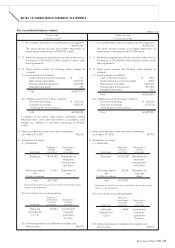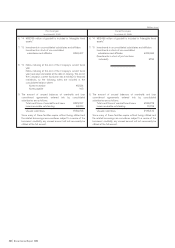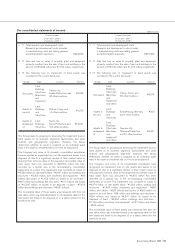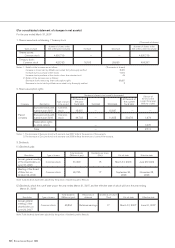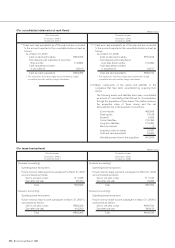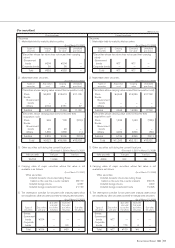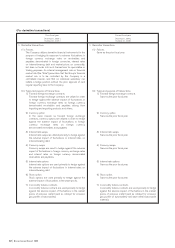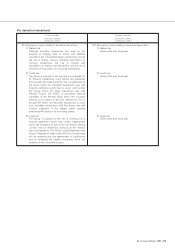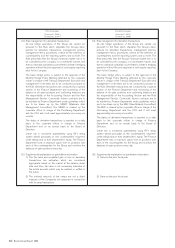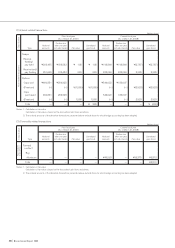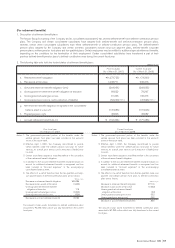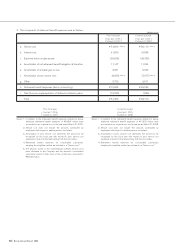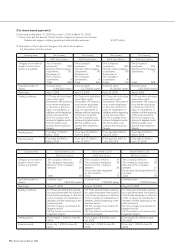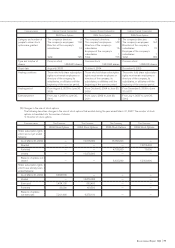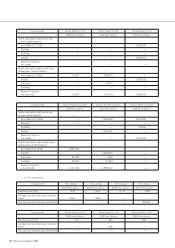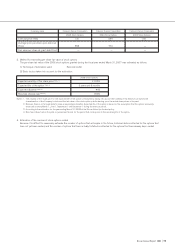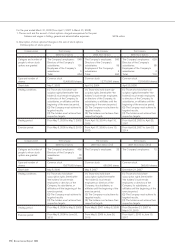Nissan 2008 Annual Report Download - page 66
Download and view the complete annual report
Please find page 66 of the 2008 Nissan annual report below. You can navigate through the pages in the report by either clicking on the pages listed below, or by using the keyword search tool below to find specific information within the annual report.
64 Nissan Annual Report 2008
Prior fiscal year Current fiscal year
From April 1, 2006 From April 1, 2007
[
To March 31, 2007
][
To March 31, 2008
]
(4) Risk management for derivative transactions
All risk hedge operations of the Group are carried out
pursuant to the Rule which stipulates the Group’s basic
policies for derivative transactions, management policies,
management items, procedures, criteria for the selection of
counterparties, and the reporting system, and so forth. The
Rule prescribes that the Group’s financial market risk is to
be controlled by the Company in a centralized manner, and
that no individual subsidiary is permitted to initiate a hedging
operation without the prior approval of, and regular reporting
back to the Company.
The basic hedge policy is subject to the approval of the
Monthly Hedge Policy Meeting attended by the corporate
officer in charge of the Treasury Department. Execution and
management of all deals are to be conducted pursuant to
the Rule. Derivative transactions are conducted by a special
section of the Finance Department and monitoring of the
balance of all open positions and confirming balances are
the responsibility of the Accounting Section and the Risk
Management Section. Commodity futures contracts are to
be handled by Finance Department under guidelines which
are to be drawn up by the MRMC (Materials Risk
Management Committee). The MRMC is chaired by the
corporate officer in charge of the Purchasing Department
and the CFO and it will meet approximately once every six
months.
The status of derivative transactions is reported on a daily
basis to the corporate officer in charge of Finance
Department and on an annual basis to the Board of
Directors.
Credit risk is monitored quantitatively using RF’s rating
system based principally on the counterparties’ long-term
credit ratings and on their shareholders’ equity. The Finance
Department sets a maximum upper limit on positions with
each of the counterparties for the Group and monitors the
balances of open positions every day.
(5) Supplemental explanation on quantitative information
1) The fair value and unrealized gain or loss on derivative
transactions are estimates which are considered
appropriate based on the market at the balance sheet
date and, thus, fair value is not necessarily indicative of
the actual amounts which may be realized or settled in
the future.
2) The notional amounts of the swaps are not a direct
measure of the Company’s risk exposure in connection
with its swap transactions.
(4) Risk management for derivative transactions
All risk hedge operations of the Group are carried out
pursuant to the Rule which stipulates the Group’s basic
policies for derivative transactions, management policies,
management items, procedures, criteria for the selection of
counterparties, and the reporting system, and so forth. The
Rule prescribes that the Group’s financial market risk is to
be controlled by the Company in a centralized manner, and
that no individual subsidiary is permitted to initiate a hedging
operation without the prior approval of, and regular reporting
back to the Company.
The basic hedge policy is subject to the approval of the
Monthly Hedge Policy Meeting attended by the corporate
officer in charge of the Treasury Department. Execution and
management of all deals are to be conducted pursuant to
the Rule. Derivative transactions are conducted by a special
section of the Finance Department and monitoring of the
balance of all open positions and confirming balances are
the responsibility of the Accounting Section and the Risk
Management Section. Commodity futures contracts are to
be handled by Finance Department under guidelines which
are to be drawn up by the RMC (Raw Material Committee).
The RMC is chaired by the corporate officer in charge of the
Purchasing Department and the CFO and it will meet
approximately once every six months.
The status of derivative transactions is reported on a daily
basis to the corporate officer in charge of Finance
Department and on an annual basis to the Board of
Directors.
Credit risk is monitored quantitatively using RF’s rating
system based principally on the counterparties’ long-term
credit ratings and on their shareholders’ equity. The Finance
Department sets a maximum upper limit on positions with
each of the counterparties for the Group and monitors the
balances of open positions every day.
(5) Supplemental explanation on quantitative information
1) Same as the prior fiscal year.
2) Same as the prior fiscal year.



